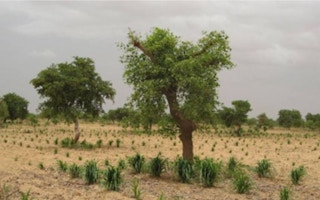President Obama is in Africa this week to discuss development, investment, health, and, notably, food security. The trip comes on the heels of the president’s groundbreaking announcement of a U.S. Climate Action Plan. So it’s a fitting time for Obama and other global leaders to take notice of a strategy that addresses both climate change and food security in Africa—re-greening.
Re-greening—a process where African farmers manage and protect trees that grow on their farms, rather than cutting them down—is already beginning to transform the continent’s drylands. Supporting and scaling up the low-tech process can not only increase crop yields in drought-prone regions, it can mitigate climate change and reduce rural poverty.
The history of re-greening in Africa’s drylands
Re-greening in Africa first garnered international attention back in 2007, when the New York Times published a front page article entitled “In Niger, Trees and Crops Help Turn Back the Desert.” Lydia Polgreen, who was the NYT’s West Africa bureau chief in those days, had visited Niger and reported “at least 7.4 million newly tree-covered acres.” The NYT article revealed that this large-scale re-greening was not due to expensive tree-planting projects, but was the result of farmers protecting and managing young trees that regenerated on their cultivated land.
This re-greening did not happen everywhere. It was observed in particular in dryland regions with high population densities. Life in dryland areas presents many challenges, and farmers and decision makers are continuously searching for ways to restore their resilience and agricultural productivity.
Since 2007, re-greening has slowly expanded throughout Africa’s drylands. Gray Tappan, a remote sensing specialist at the U.S. Geological Survey’s EROS data center, reported in 2009 that the area re-greened by farmers in the densely populated parts of Niger was not 7.4 million acres, but 12 million acres. Farmers in Niger have protected and managed at least 200 million new trees over the past two decades.
Farmers in other parts of the Sahel have also begun to invest in on-farm trees. For instance, on Mali’s Seno Plains, on-farm tree densities have increased on more than one million acres. Increasing numbers of farmers in Burkina Faso, Ethiopia, and Senegal are also beginning to adopt re-greening practices. Many more examples of on-farm re-greening in the Sahel can be read on the Africa Re-greening Initiatives blog.
The benefits of farmer-managed re-greening
Hundreds of millions of additional trees across Africa’s agricultural landscapes sequester significant quantities of carbon dioxide. By increasing the number of on-farm trees, farmers in Niger and other nations are helping to mitigate climate change.
At the same time, increased tree density on farms helps farmers adapt to the effects of climate change and increase food security. On-farm trees reduce wind speed and produce shade for crops, reducing loss of water through evaporation. The added leaf litter also helps replenish organic matter in the soil and increase moisture-holding capacity, boosting soil fertility and crop yields. Niger, for example, faced a significant national grain deficit in 2012 due to erratic rainfall in 2011. Meanwhile, Niger researchers found that a district with high on-farm tree densities had produced a grain surplus of almost 14,000 tons in 2011.
Farmers also tend to protect particular species of trees that provide benefits beyond the cropland. These trees can produce fodder for livestock, as well as wood for cooking, home construction, and for sale in local markets. The integration of trees into farming systems contributes to the sustainable intensification and diversification of agricultural production, along with increased household incomes and resilience to climate change.
Scaling up re-greening in Africa
Much has been done to boost re-greening in the Sahel, but much more remains to be done. There is ample opportunity for increasing the number of on-farm trees as well as the diversity of trees throughout Africa’s drylands.
A major challenge is devising policies and legislation that stimulate tens of millions of farmers to invest in protecting and managing on-farm trees. Working with farmers to increase the number of on-farm trees can be one of the most cost-effective ways to boost crop production and to scale up “climate smart” agricultural practices that directly contribute to increased food and livelihood security for Africa’s smallholder farmers. The World Resources Institute and its partners are now developing a strategy for scaling re-greening successes based on experience already gained in the Sahel and other regions.
But really growing Africa’s re-greening requires cooperation from multiple stakeholders. Global leaders like President Obama, ministers of agriculture and forestry, NGOs supporting rural and agricultural development, and other decision makers can engage with African farmers to identify key interventions and scale up successes. President Obama and his team, for example, have developed “Feed the Future,” a global anti-hunger and food security initiative. This strategy can achieve some of its goals more quickly and cost-effectively if it supports the development of another kind of Green Revolution—one that helps farmers increase the number of trees in their farming systems and restores the productivity of degraded lands.
Agroforestry is a key opportunity to improve food security and spur climate change mitigation and adaptation. Farmers in Tigray, Ethiopia have told me and others that “trees are our backbone.” They are right. There is no future for agriculture in many drylands around the world without an increase in the number of on-farm trees.
This post originally appeared here. Chris Reij is a Sustainable Land Management specialist of the Centre for International Cooperation, VU University Amsterdam and a Senior Fellow of the World Resources Institute in Washington.










